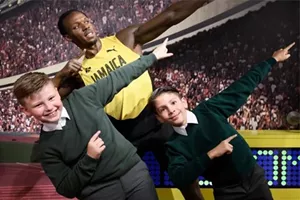
KS2/KS3 pupils have the opportunity to learn
In English…
- To identify the different types of media and their purposes.
- To explore and critique how the media present information and use language to create meaning.
- To understand the concept of ‘fake news’ and why it is important.
In PSHE and Citizenship…
- To understand how the media portrays young people and to recognise its possible impact.
- To explore how identity is affected by the media
Before you visit
Download our pre- and post- lesson plans. With three hours’ worth of content students will explore the media, fake news, and celebrity culture. This resource will stretch students' English subject knowledge by delving into the complex world of the media and developing their critical literacy skills.
Download hereThe Experience
We would recommend students be prompted to complete ‘learning checkpoints’ or discussion points/tasks as they walk around the attraction; this will help guide and structure their learning through the various interactive and exciting zones. Just pick your theme and start exploring some example talking points on how your pupils learning experience could unfold!
Example discussion point 1: Children should consider the definition of fame. Would they like to be famous? Why/why not?
Example task 1: To review a list of some of the celebrities in the attraction and order them from most famous to least famous, giving reasons for choices. Who is on the A-List and who is on the B-List? How does it help children to define what we mean by ‘fame.’
Example discussion point 1: Ask children to consider what we mean by ‘celebrity culture’. What is our current celebrity culture? What role does the media play in this culture? Can we say that the media controls and defines this culture?
Example task 1: To imagine/create a private dialogue between two celebrities in Awards party. What would they say to each other? What would they have in common? Pupils should write an inner monologue for one or more of the celebrities, expressing how they really feel about the pressures of their celebrity status.
Example discussion point 2: Pupils should choose a celebrity and consider how they represent modern celebrity culture. How does their figure show the relationship between celebrity/fame and the media?
Example task 2: To create a selfie with a celebrity in A-list. What are the pressures when trying to create the perfect selfie? Why do people feel motivated to do it? How does it make them feel?
Example discussion point 1: Pupils should consider what it takes to be in the limelight as a fashion model, in front of millions of people. What personality traits are required? What are the challenges of this job?
Example task 1: To walk down the runway and record the different sensations of the experience using descriptive language and sensory description: sight, sound, touch, taste, smell.
** Pause/rest-bite**
Example discussion point 2: While children take a short break, they should watch how other visitors are interacting with the celebrities in the attraction. What do they notice?
Example task 1: To record observations of how members of the public interact with the attraction. What do they find interesting? What sorts of things do they do? What do they enjoy? Why do they enjoy it?
Example discussion point 1: Ask children to consider the term ‘fake news’. What does it mean? What different types of fake news are there?
Example task 1: To analyse a variety of news stories about one or more of the celebrities in the attraction (written/compiled specifically for the exercise) and to assess whether they think it is real or fake, picking out textual evidence to back up their decisions.
Example discussion point 2: Pupils should think about a recent election in the USA or the UK. Did fake news play a role in the election? How? Why is fake news dangerous when it comes to politics?
Example task 1: To write either a fake or a real headline in the style of a newspaper headline and swap it with other members of the class. Who is the best at spotting the fake news?
Example discussion point 1: Pupils should consider how fame has changed over time. How has the media contributed to these changes?
Example task 1: To analyse the fame experienced by The Beatles in the 1960s compared to the fame experienced by someone famous today. What is the same? Was it different?
Example discussion point 1: Pupils should be prepared before entry to the 4D cinema to consider how the experience engages them physically, mentally and emotionally – and why this is effective.
Example task 1: To create a new type of media for the future inspired by the experience in the 4D cinema.
"Our children had an amazing time taking 'selfies' and pictures with all their favourite idols and famous people. They especially loved the cinema watching their super heroes in action!"
Always love to visit the models. Some of our students had not been before so were bowled over at the likeness of some of the figures. I liked the hologram dance-along, that wasn't there on my last visit. More interacting would be welcomed. Me and two other teachers in our group even gave the catwalk a go!"